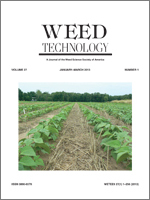Vapor movement of synthetic auxin herbicides can injure desirable plants outside the treatment zone. Vapor movement of the synthetic auxin herbicides aminocyclopyrachlor and aminocyclopyrachlor methyl was compared with that of the relatively volatile herbicide dicamba and the low volatile herbicide aminopyralid with a soybean bioassay under greenhouse and field conditions. Soybean is very sensitive to these active ingredients. Under greenhouse conditions, 82 (61 to 104) mg ae ha−1 of aminocyclopyrachlor, 26 (18 to 33) mg ae ha−1 of aminocyclopyrachlor methyl, 82 (69 to 95) mg ae ha−1 of aminopyralid, and 61 (47 to 75) mg ae ha−1 of dicamba produced an estimated 25% visual soybean phytotoxicity response when soybean was treated POST at the V3 growth stage (GR25 [95% confidence interval]). In field studies, aminocyclopyrachlor, aminocyclopyrachlor methyl, and aminopyralid were applied at 70 g ae ha−1 and dicamba was applied at 560 g ae ha−1 (labeled application rates) to soybean at the V3 growth stage. All herbicides were applied within an enclosed chamber (3 m by 3 m by 1 m) to mitigate movement of spray droplets. The enclosures were removed shortly after spray application and soybean response immediately surrounding the treated area was recorded in each of eight directions approximately 10 d after treatment. On the basis of bioassay responses, relative amount of vapor movement was dicamba > aminocyclopyrachlor methyl > aminopyralid ≈ aminocyclopyrachlor. Vapor movement of aminocyclopyrachlor was very low indicating that the risk of phytotoxic response of sensitive plants due to volatility of aminocyclopyrachlor is negligible.
Nomenclature: Aminocyclopyrachlor; aminopyralid; dicamba; soybean, Glycine max (L.) Merr.
El movimiento de vapores de herbicidas auxinas sintéticas puede dañar plantas deseables fuera de la zona de tratamiento. El movimiento de vapores de los herbicidas auxinas sintéticas aminocyclopyrachlor y aminocyclopyrachlor methyl fue comparado con el del herbicida relativamente volátil dicamba y del herbicida de baja volatilidad aminopyralid con un bioensayo con soya bajo condiciones de invernadero y de campo. La soya es muy sensible a estos ingredientes activos. Bajo condiciones de invernadero, 82 (61 a 104) mg ae ha−1 de aminocyclopyrachlor, 26 (18 a 33) mg ae ha−1 de aminocyclopyrachlor methyl, 82 (69 a 95) mg ae ha−1 de aminopyralid, y 61 (47 a 75) mg ae ha−1 de dicamba produjeron un estimado de 25% de respuesta de fitotoxicidad visual en la soya cuando la soya fue tratada POST en el estado de desarrollo V3 (GR25 [95% intervalo de confianza]). En los estudios de campo, aminocyclopyrachlor, aminocyclopyrachlor methyl, y aminopyralid fueron aplicados a 70 g ha−1 y dicamba fue aplicado a 560 g ha−1 (dosis de aplicación según la etiqueta) a soya en el estado de desarrollo V3. Todos los herbicidas fueron aplicados dentro de una cubierta cerrada (3 m por 3 m por 1 m) par mitigar el movimiento de gotas de aspersión. Las cubiertas fueron removidas poco después de la aplicación y la respuesta de la soya localizada inmediatamente alrededor del área tratada fue registrada en cada una de las ocho direcciones aproximadamente 10 días después del tratamiento. Con base en las respuestas de los bioensayos, el movimiento relativo del vapor fue dicamba > aminocyclopyrachlor methyl > aminopyralid ≈ aminocyclopyrachlor. El movimiento del vapor de aminocyclopyrachlor fue muy bajo, indicando así que el riesgo de la respuesta de fitotoxicidad de plantas sensibles debido a la volatilidad de aminocyclopyrachlor es insignificante.





